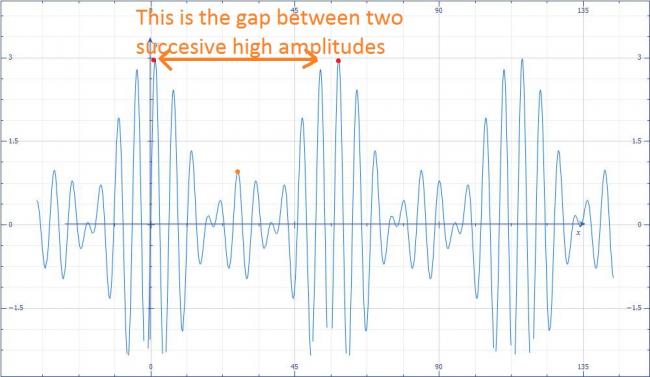Please be patient and read the solution
Ans-2
I assume that you know the basics of beat.
Beats is interference of two or more waves with a little difference in frequency. The rest is same i.e., the medium, the initial phase and the direction of propagation
Consider a beat formed by two waves-
y1 = A sin (wt - kx) and y2 = A sin (Wt - kx) [with frequencies w and W]
Equation of beats is the trajectory of the particle at origin.
so, y(net, x=0) = A sinwt + AsinWt= 2A cos[(w-W)t/2] sin[(w+w)t/2]
At t=0, y1 = y2 = 0 (due to phase)
So, at t=0, ynet,x=0 = 0, due to phase.
As y(net, x=0) = 2A cos[(w-W)t/2] sin[(w+w)t/2]
and at t=0, sin[(w+w)t/2] is zero, the sine function is phase.
So, particle at origin oscillates with Amplitude = 2A cos[(w-W)t/2 Phase function = sin[(w+w)t/2]
If you observe the plot of beats, the Amplitude (Cosine function) in its period, takes Maximum values when Cos gives +1 or -1. So, in one cycle of Cosine function, there are two Amplitude extremums- Maximum magnitude i.e., Amplitude is maximum twice in one cycle
In a beat, there is only one Amplitude maxima, i.e., Amplitude is maximum only once in once cycle.
If the time period of Amplitude is T(A), time period of beats is T(b)=T(A)/2 as in one cycle of Amplitude function, there are two cycles of beats.
If frequency of Amplitude function is V(A), frequency of beats is V(b) = 2V(A)
Now the question-
waves are
y1 = Asin (wt - kx); w=2Î v
y2 = Asin (w2t - kx); w2=2Î (v-1) = 2Î v - 2Î = w - 2Î
y3 = Asin (w3t - kx); w3 =2Î (v+1) = 2Î v + 2Î = w + 2Î
As per the derivation;
y(net, x=0) = A [sin wt + sin w2t + sin w3t ]
= A [ sin wt + sin (w - 2Î )t + sin (w + 2Î )t ]
=A [sinwt +2 sin(wt) cos(2Î t)]
=A[1 + cos2Î t] sin wt
Amplitude Function = A[1 + cos2Î t] = f(t)
As the function is simple a cosine function, the period can be found very easily. Let it be T,
f(t)= f(t+T)
or A[1 + cos2Î t] = A[1 + cos {2Î t + 2Î T}
or 2Î T=2Î
or T=1s
the amplitude has a time period of 1 second. As the amplitude is simple cosine formula, the time period of beats T(b) is T/2=1/2s as discussed above
Frequency of beats= 1/T(b)
=2 per second
